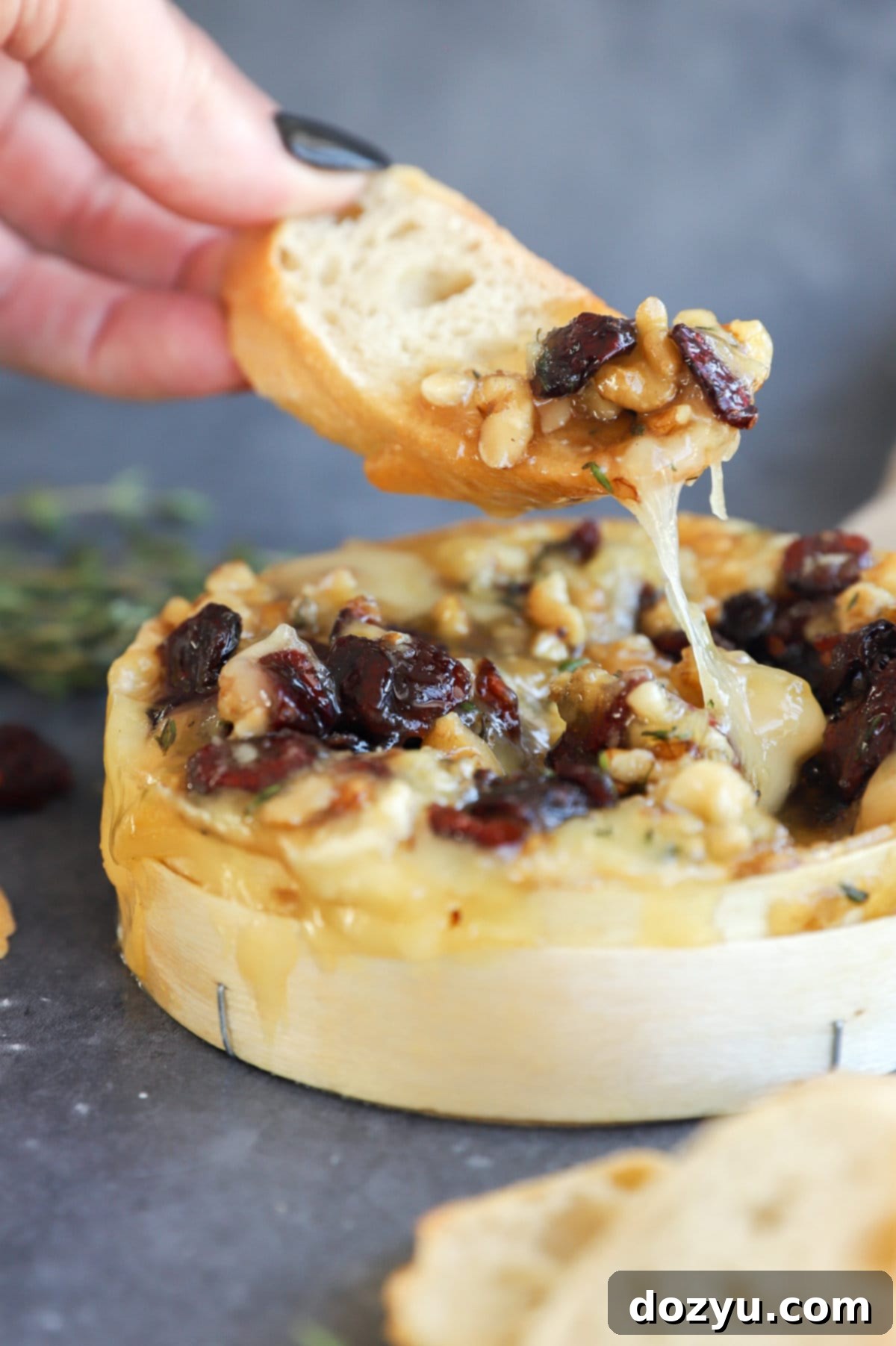Delicious Baked Camembert with Cranberries & Walnuts: The Ultimate Fall & Holiday Appetizer
Easy Baked Camembert with dried cranberries and walnuts is a delightful and sophisticated way to enhance your fall and holiday gatherings. This irresistibly creamy cheese dish is infused with seasonal flavors, offering warmth and indulgence with minimal effort. It’s the perfect appetizer for sharing joy and coziness throughout the festive season, effortlessly transforming any get-together into a memorable occasion.

Table of Contents
Toggle
About This Irresistible Baked Camembert
As the crisp autumn air signals the beginning of the holiday season, our thoughts naturally turn to warm gatherings, cherished company, and delectable food. There’s a special kind of magic in the fall, a time when creating comforting and inviting dishes becomes a joyful endeavor. This baked Camembert recipe perfectly captures that festive spirit, offering a taste of the season in every gooey, savory bite.
If you’re searching for an impressive yet remarkably easy appetizer to serve at your upcoming celebrations, look no further. This dish effortlessly marries simplicity with pure indulgence, making it ideal for Thanksgiving dinners, Christmas parties, or simply a cozy night in. The mild, earthy notes of Camembert cheese provide a luxurious base, beautifully complemented by the sweet-tart burst of dried cranberries, the satisfying crunch of toasted walnuts, and the aromatic hint of fresh thyme. It’s a versatile crowd-pleaser that guarantees smiles and fosters warmth, inviting everyone to dip into its molten center.
What is Baked Camembert?
Baked Camembert is a quintessential indulgent appetizer, celebrated for its rich, gooey texture and exquisite flavor. It involves gently heating a wheel of Camembert cheese until its interior transforms into a sumptuously creamy, molten delight. Typically, the cheese is baked either in its original wooden box (ensuring all plastic packaging is removed) or in a small ovenproof dish that snugly fits the cheese wheel. This method prevents the cheese from spreading too much and helps it retain its iconic shape while melting.
While some recipes suggest scoring the top rind before baking, this particular approach takes it a step further. We remove the top rind entirely, creating an open canvas for a luscious, flavorful topping. Our unique blend features sweet brown sugar, tart dried cranberries, crunchy toasted walnuts, fragrant thyme, and a pinch of salt. This topping bakes into a delightful crust that perfectly contrasts the smooth, warm cheese beneath. The result is a luxurious, savory-sweet cheese dip that is perfect for pairing with toasted baguette slices, crisp crackers, or even fresh vegetable sticks. Any cheese enthusiast will adore this warm, flavorful, and incredibly satisfying dish, making it a standout appetizer or snack for any holiday or special occasion.
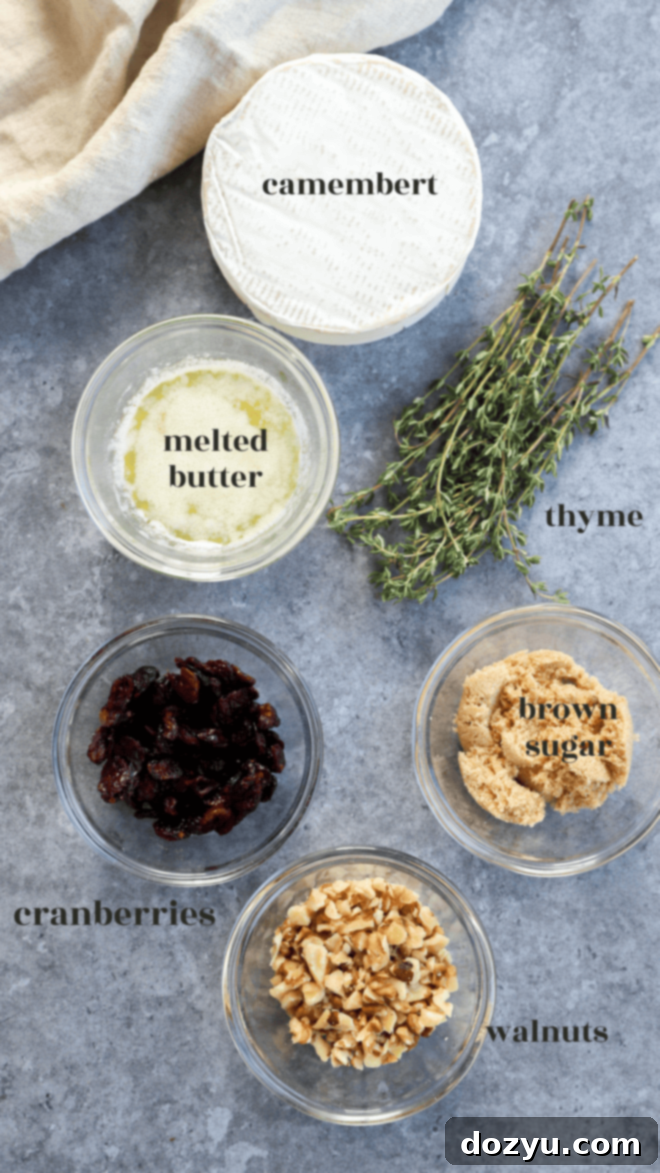
Essential Ingredients
Crafting this elegant baked Camembert appetizer requires just a handful of simple yet high-quality ingredients. Each component plays a crucial role in delivering the harmonious blend of flavors and textures that makes this dish so irresistible.
- Camembert: The star of our show! You’ll need an 8-ounce wheel of Camembert cheese. Its distinct earthy, mushroom-like flavor and creamy texture are paramount to this recipe’s success. If Camembert is unavailable, a wheel of Brie cheese makes an excellent substitute, offering a similar soft, melty consistency and a slightly milder, buttery flavor.
- Walnuts: We recommend using toasted, chopped walnuts. Toasting enhances their natural nuttiness and adds a deeper layer of flavor and aroma. You can purchase them pre-toasted and chopped for convenience, or toast whole walnuts in a dry skillet over medium heat for a few minutes until fragrant, then chop them by hand. For a slight variation, other nuts like pecans or even chopped hazelnuts can be used.
- Dried Cranberries: These provide a wonderful sweet and tart counterpoint to the rich cheese. It’s crucial to use dried cranberries (often called craisins) for this recipe, not fresh ones. Fresh cranberries contain too much moisture, which would release liquid during baking and negatively impact the topping’s consistency and the cheese’s texture. The chewy texture of dried cranberries also adds a pleasant contrast.
- Brown Sugar: This recipe calls for brown sugar, which contributes a lovely caramel note and helps create a beautifully glazed topping. Both light brown sugar and dark brown sugar work well; dark brown sugar will offer a slightly richer, deeper molasses flavor.
- Butter: Unsalted butter is preferred for this recipe. Using unsalted butter allows you to control the overall saltiness of the dish more precisely. If you only have salted butter on hand, be sure to reduce or entirely omit the kosher salt specified in the recipe to avoid over-salting. The melted butter binds the topping ingredients together and adds richness.
- Thyme: Fresh thyme leaves are highly recommended for their vibrant, aromatic, and slightly peppery flavor that pairs exceptionally well with cheese and cranberries. If fresh thyme is not accessible, you can use dried thyme, but remember to halve the amount (use only 1/2 teaspoon of dried thyme) as dried herbs are more concentrated. Finely chop the dried thyme before incorporating it. Fresh rosemary is another fantastic aromatic alternative that adds a different, yet equally appealing, herbal dimension.
- Salt: Fine kosher salt is all you need. It helps to balance the sweetness of the cranberries and brown sugar, enhancing all the flavors in the topping and the cheese itself.
Everyday Seasonal Cookbook
Unlock a world of seasonal culinary inspiration with our “Everyday Seasonal Cookbook.” Packed with comprehensive produce guides, innovative recipes, and invaluable cooking tips, this cookbook ensures you have access to the freshest flavors for every occasion, all year round. It’s your ultimate resource for embracing the bounty of each season in your kitchen.
Must-Have Kitchen Tools
This recipe prides itself on its simplicity, extending to the minimal kitchen equipment required. You won’t need any specialized gadgets, just a few basic items to bring this delicious appetizer to life.
- Small Mixing Bowl: Essential for combining the butter, sugar, cranberries, walnuts, thyme, and salt into a cohesive and flavorful topping. A bowl that’s just the right size will make mixing effortless.
- Spoon: For stirring the topping ingredients and later for spooning the mixture evenly over the Camembert.
- Sharp Knife: Crucial for carefully removing the top rind of the Camembert cheese, allowing the topping to melt directly into the creamy interior.
- Baking Sheet: This is a non-negotiable item. Even if you bake the Camembert in its wooden box, placing it on a baking sheet provides a vital safety net. It catches any potential cheese spills or butter drips, keeping your oven clean and preventing any burning. It also makes transferring the hot cheese in and out of the oven much easier.
- Oven-Safe Dish (Optional): While the wooden box the Camembert comes in is often oven-safe and perfectly suitable, a small, shallow, round baking dish (like a ramekin or a larger crème brûlée dish) can be used if you prefer. The key is to ensure the dish fits the wheel of cheese snugly. If the dish is too large, the cheese might spread out excessively as it melts, creating a thinner, less appealing puddle rather than a beautifully contained, gooey dip. The snug fit helps the cheese maintain its thickness and creamy consistency.

How to Make Baked Camembert: Step-by-Step
Preparing this baked Camembert is incredibly straightforward, designed for efficiency without compromising on flavor or presentation. Follow these simple steps for a truly impressive appetizer:
Craft the Cranberry-Walnut Topping
In your small mixing bowl, combine the melted butter and brown sugar. Stir them together until you achieve a smooth, well-integrated mixture. Next, gently fold in the dried cranberries, chopped toasted walnuts, fresh thyme leaves, and kosher salt. Mix thoroughly to ensure all ingredients are evenly distributed and coated. Once combined, set this flavorful topping aside. This allows the flavors to meld slightly while you prepare the cheese.
Prepare the Camembert Cheese
First, preheat your oven to 350˚F (175˚C). Unwrap the Camembert cheese wheel completely. Locate the bottom of the cheese, which is typically where the rind meets or folds together. Flip the cheese so this bottom side is now facing upwards. Using a very sharp knife, carefully slice off the entire top layer of the rind. This creates an open surface for your delicious topping. Place the prepared Camembert, cut side up, into its original wooden box (ensuring any plastic liner is removed) or into a snugly fitting oven-safe baking dish. Position this on a baking sheet; this extra precaution helps catch any potential drips during baking.
Assemble and Layer
Take your cranberry-walnut mixture and generously spoon it over the exposed, cut surface of the Camembert cheese. Spread the topping evenly across the entire surface, ensuring a uniform layer. This not only guarantees a burst of flavor in every bite but also creates a beautiful visual appeal as it bakes.
Bake to Perfection
Carefully place the baking sheet with the assembled Camembert into your preheated oven. Bake for approximately 12 to 15 minutes, or until the cheese is wonderfully gooey and melted in the center, and the topping is slightly caramelized and fragrant. The exact time may vary slightly depending on your oven and the cheese’s starting temperature. Once baked, remove from the oven and serve immediately. This warm, molten cheese is best enjoyed right away with accompanying toasted slices of French baguette or an assortment of crackers, allowing everyone to scoop up its decadent goodness.
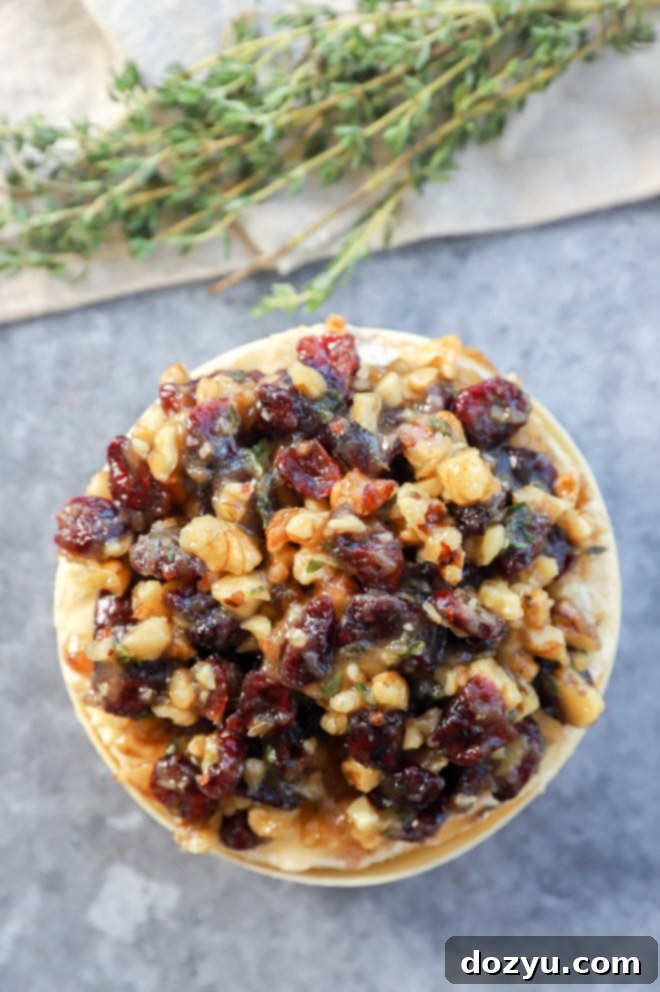
Expert Tips and Tricks for Perfect Baked Camembert
Achieving a perfectly gooey and delicious baked Camembert is simple, but a few expert tips can elevate your dish from good to extraordinary:
- Embrace the Wooden Box: Many Camembert wheels come in a lovely wooden box, which is often oven-safe and perfect for baking. Always remember to remove any plastic wrapping or paper labels before placing it in the oven. To prevent the wooden box from potentially burning or charring, you can wrap it loosely in aluminum foil. Even with the box, always place it on a baking sheet. This crucial step acts as a safeguard, catching any cheese that might bubble over the edges as it melts, keeping your oven clean and preventing any smoky incidents.
- Synchronize Your Toast: Maximize your oven time! While your Camembert bakes, use the same oven to toast slices of French baguette or your favorite crackers. Arrange them on a separate baking sheet and place them in the oven alongside the cheese. In the 12-15 minutes it takes for the cheese to melt into gooey perfection, your bread should become perfectly golden and crisp, creating an ideal pairing.
- Brie as an Alternative: If Camembert is difficult to find or if you prefer a slightly milder flavor, a wheel of Brie cheese is an excellent substitute. Brie shares a similar creamy texture when baked and will perform beautifully in this recipe, absorbing the flavors of the cranberry-walnut topping just as well.
- Introduce Citrus and Fresh Fruits for Zest: For an additional layer of brightness and complexity, consider adding a touch of orange zest to your cranberry-walnut mixture. The citrusy aroma and flavor will beautifully complement the cranberries and cheese. Alternatively, for a fresh and vibrant twist, macerate some fresh berries like sliced strawberries or raspberries with a hint of sugar and pile them on top of the baked Camembert just before serving. These fresh fruits introduce a sweet, juicy counterpoint to the savory, rich cheese, adding a delightful seasonal spin.
- Consider a Drizzle of Honey or Maple Syrup: Just before serving, a light drizzle of high-quality honey or maple syrup can add another dimension of sweetness and a beautiful sheen to the top of your baked Camembert. This touch enhances the festive feel and adds a lovely glaze.
- Herb Variations: While thyme is fantastic, don’t shy away from experimenting with other herbs. Fresh rosemary, finely minced, offers a more pungent, piney aroma that can be quite appealing with walnuts and cranberries. A touch of finely chopped sage could also add a unique, earthy note.
- Spice it Up: For a hint of warmth, a tiny pinch of cinnamon or a very small grating of fresh nutmeg could be incorporated into the topping mixture, especially appealing during the cooler months.
More easy cheesy appetizers to try out: Spinach and Artichoke Goat Cheese Dip | Roasted Cranberry Goat Cheese Crostini | Crab Rangoon Dip | Chipotle Chili Cheese Dip

Baking Duration for Camembert
One of the many appealing aspects of this baked Camembert recipe is its incredibly short baking time, making it an ideal appetizer for even last-minute entertaining. A wheel of Camembert cheese typically requires only about 12 to 15 minutes in a preheated oven at 350˚F (175˚C). The goal is to heat the cheese just enough for its interior to become luxuriously molten and gooey, resembling a thick, creamy dip, without overcooking it to the point of separating. This rapid cooking time ensures you can prepare and serve a warm, inviting appetizer with minimal waiting, perfect for bustling holiday hosting or a quick, comforting treat.
The Distinctive Taste of Camembert
Camembert cheese boasts a unique and appealing flavor profile that makes it a favorite among cheese connoisseurs. It is primarily known for its delightful earthy notes, which some describe as reminiscent of mushrooms or even truffle, particularly as it ages. The cheese has a soft, creamy, almost runny texture at room temperature, which becomes even more luscious and molten when baked. Its flavor is generally rich yet mild, with a slightly tangy finish. The edible bloomy rind, a natural part of the cheese-making process, contributes to its distinctive aroma and adds a subtle complexity that enhances the overall taste experience. When paired with sweet, tart, and crunchy toppings like cranberries and walnuts, the Camembert’s inherent flavor blossoms, creating a well-rounded and deeply satisfying culinary experience.
Baking Brie vs. Camembert
Both Brie and Camembert cheeses are excellent candidates for baking, and they perform quite similarly when heated. Both are soft, creamy, cow’s milk cheeses with edible white rinds, which soften beautifully in the oven. When baked, their centers transform into a warm, gooey, molten dip, making them perfect for scooping with toasted bread, crackers, or fresh vegetables. The primary difference when baking comes down to subtle flavor nuances and how they interact with additional toppings. While both yield a delicious result, Camembert tends to have a more pronounced, earthy flavor that stands up well to robust toppings, whereas Brie offers a slightly milder, buttery profile. Ultimately, you can confidently bake either, choosing based on your personal preference for cheese intensity.
Camembert vs. Brie: Key Differences
While often compared and frequently used interchangeably in recipes like baked cheese, Camembert and Brie do have distinct differences. Both are soft-ripened, bloomy-rind cow’s milk cheeses, but their origins and production methods lead to subtle variations:
- Fat Content and Texture: The most significant difference lies in their fat content. Brie traditionally has cream added during its production, resulting in a slightly higher fat content. This makes Brie generally richer, even creamier, and often a bit more spreadable at room temperature compared to Camembert.
- Flavor Profile: Camembert typically has a more robust, earthy, and sometimes more pungent flavor. Connoisseurs often describe notes of mushrooms, garlic, and even grass in Camembert. Brie, on the other hand, tends to be milder, with a delicate, buttery, and often fruitier flavor.
- Size and Shape: Brie traditionally comes in larger wheels, while Camembert is typically sold in smaller, round wheels, often packaged in wooden boxes.
- Origin: Brie originates from the Brie region of France, while Camembert hails from Normandy.
For a warm appetizer, Camembert’s more intense and earthy flavor makes it an especially ideal candidate. Its bold character stands up wonderfully to the sweet-tartness of cranberries and the rich crunch of walnuts, creating a more dynamic and memorable taste experience compared to the generally milder Brie.
Is the Rind on Camembert Edible?
Yes, absolutely! The white, bloomy rind on Camembert cheese is not only perfectly safe to eat but is also an integral part of the cheese’s flavor and texture profile. This rind is formed naturally by a mold (Penicillium candidum) that helps the cheese ripen from the outside in. It contributes to the cheese’s unique earthy aroma and adds a slight tang and a different texture that complements the creamy interior. Many cheese enthusiasts consider eating the rind to be essential for the full Camembert experience.
It’s important to differentiate this natural rind from artificial wax rinds sometimes found on other cheeses, which are indeed inedible. Wax rinds are typically shiny, often colorful, and are used purely for preservation. The soft, powdery white rind of Camembert is completely natural, delicious, and intended to be consumed.
Need more inspiration for party bites? Check out my appetizers recipe page!
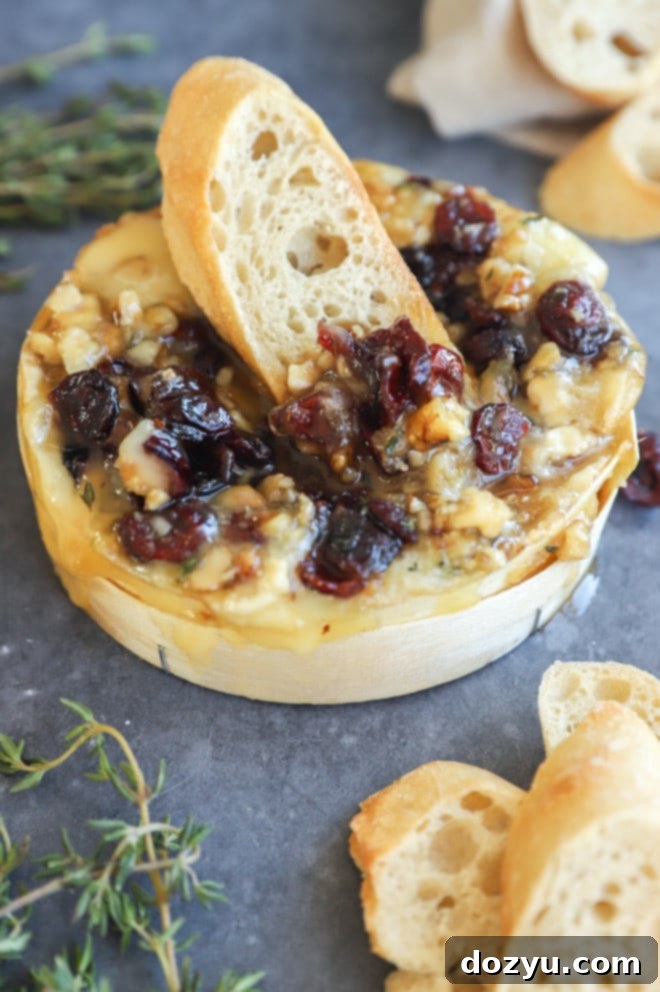
Serving Suggestions for Baked Camembert
Baked Camembert with cranberries and walnuts is a versatile appetizer that pairs beautifully with a variety of accompaniments. The key is to choose items that can effectively scoop up the warm, gooey cheese while complementing its rich flavors.
- Bread and Crackers: The most classic pairing! Serve with thinly sliced, toasted French baguette, artisan crackers, or even pita chips. The crunchy texture provides a delightful contrast to the creamy cheese.
- Fresh Fruit: Offer slices of crisp apples (like Honeycrisp or Granny Smith), firm pears, or even grapes. Their natural sweetness and acidity cut through the richness of the cheese.
- Crudités: For a lighter option, serve with an assortment of fresh vegetables such as carrot sticks, celery sticks, bell pepper strips, cucumber slices, or blanched asparagus spears.
- Seasonal Cocktails: Elevate your appetizer with a perfectly matched seasonal drink. If you’re planning this for Thanksgiving, a simple Thanksgiving cocktail with its complementary flavors would be an excellent choice. For apple enthusiasts, an apple pie old fashioned cocktail offers a warm, boozy twist reminiscent of autumn desserts.
- Wine Pairings: A dry white wine like Sauvignon Blanc or a light-bodied red like Pinot Noir would complement the earthy notes of Camembert without overpowering it. A sparkling wine or Champagne also pairs beautifully, as its effervescence can cleanse the palate.
- For a Hearty Holiday Meal: If this baked Camembert is a starter for a larger holiday feast, consider serving it before main dishes like an air fryer bacon-wrapped pork loin, which comes with a simple roasted red wine cranberry chutney for a cohesive flavor profile. For a more traditional holiday meal, an easy beer-brined turkey breast or using this turkey brine recipe for your roasted bird would complete the festive menu.
Storage and Reheating Tips
While baked Camembert is undoubtedly best enjoyed fresh out of the oven, any leftovers can be stored and reheated. Here’s how to do it effectively to preserve its deliciousness:
- Storage: Allow the baked Camembert to cool completely to room temperature. Once cooled, transfer any remaining cheese and topping to an airtight container. Store it in the refrigerator for up to 3 to 4 days. While the texture won’t be as molten as freshly baked, it will still retain its wonderful flavor.
- Reheating: To reheat, transfer the desired portion of baked Camembert back into a small oven-safe dish or place it on a microwave-safe plate.
- Microwave: Reheat in the microwave in 30-second to 1-minute intervals until it’s warmed through and once again gooey and soft. Be careful not to overheat, as this can make the cheese oily.
- Oven: For the best texture, reheat in a preheated oven at 300°F (150°C) for about 5-10 minutes, or until the center is melted and warm. This method helps the topping crisp up slightly again.

More Delicious Cheese Recipes
If you’re a fan of rich, cheesy appetizers, explore some of our other delectable recipes that are sure to please any palate:
- Whipped Goat Cheese Salsa Dip: This easy, cold cheese dip comes together in minutes, making it perfect for last-minute entertaining or a casual snack.
- Cranberry Walnut Goat Cheese Ball: A classic and beloved appetizer, this cheese ball is packed with aromatic winter herbs and the tangy goodness of goat cheese, making it a holiday staple.
- Apple Cranberry Baked Brie: If you love baked cheese, this recipe is a must-try. It combines the buttery richness of Brie with the sweet-tartness of apples and cranberries, making it an irresistible highlight for any holiday gathering.
Finally, we’d love to hear from you! If you prepare this baked Camembert with cranberries and walnuts recipe, please take a moment to give it a rating and/or leave a comment below. Your feedback is incredibly valuable, and we make sure to respond to every single comment. Feel free to share any questions you might have about the recipe, too!
And for those who love to share their culinary creations, be sure to tag us on Instagram if you make this recipe! Seeing these dishes come to life in your homes is truly inspiring and means the world to us.
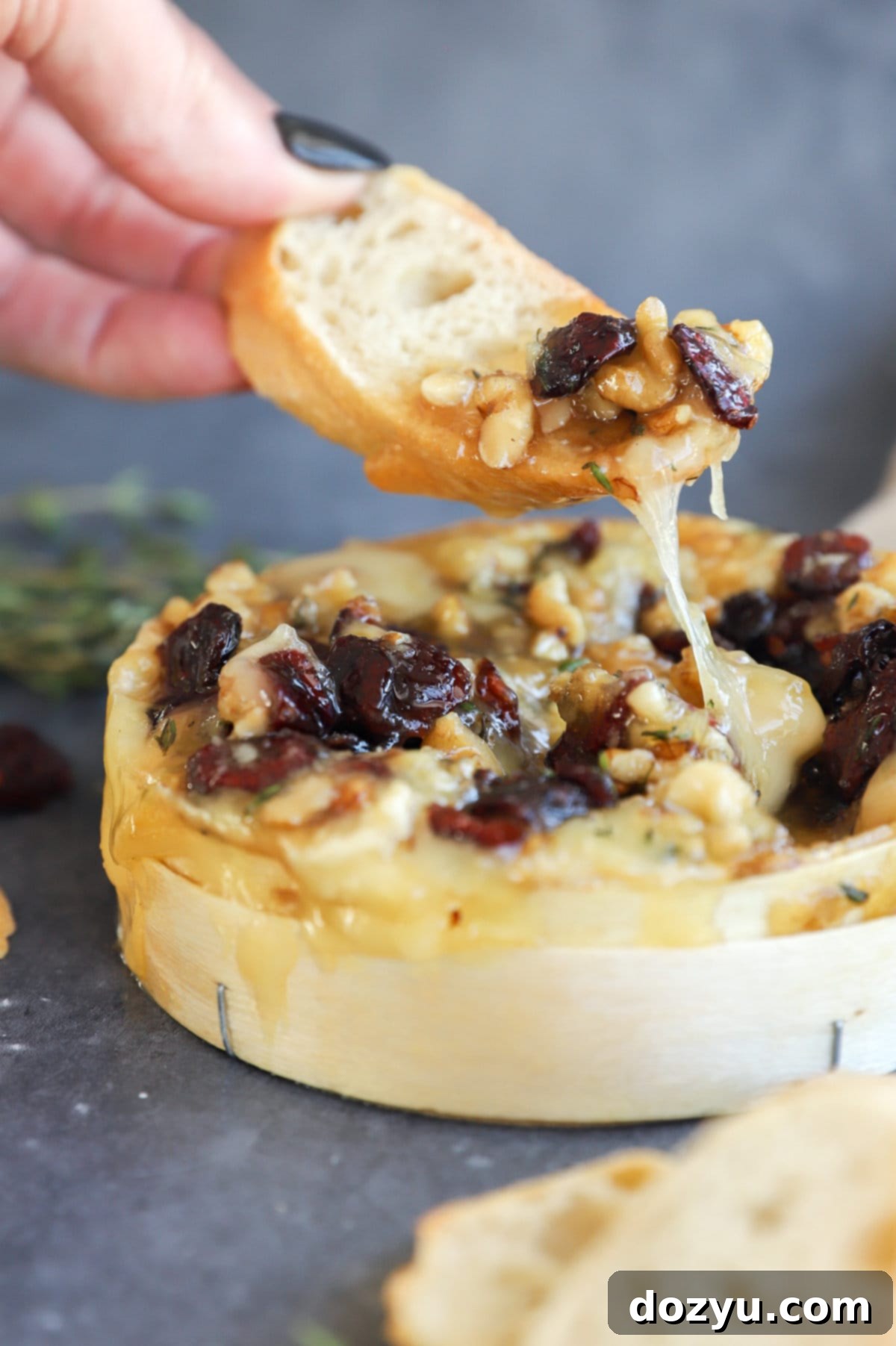
Baked Camembert with Cranberries and Walnuts
5 minutes
15 minutes
20 minutes
6
prevent your screen from going dark
Equipment Needed
-
small mixing bowl
-
round baking dish optional
Ingredients
-
3
Tbsp
unsalted butter
melted -
3
Tbsp
brown sugar -
1/3
cup
dried cranberries -
1/3
cup
walnuts
toasted and chopped -
1
tsp
fresh thyme leaves
chopped -
1/8
tsp
kosher salt -
8
oz
wheel of camembert cheese - toasted sliced of French bread or crackers
Instructions
-
Preheat the oven to 350˚F.
-
In a small bowl, combine the melted butter and sugar. Stir to combine. Fold in the cranberries, walnuts, thyme, and salt.
-
Flip the camembert so the bottom is on top (where the rind comes together). Using a sharp knife, remove the top rind of the cheese. Place the camembert cut side up in an oven-safe round baking dish (like a larger crème brûlée dishes). You can also use the wood container the cheese came in as the baking vessel!
-
Cover the top of the cheese with the cranberry walnut topping in an even layer.
-
Bake for 12 to 15 minutes until gooey. Serve immediately with toasted slices of French bread or crackers.
Video
Nutrition Information
Serving:
1
g
|
Calories:
250
kcal
|
Carbohydrates:
13
g
|
Protein:
9
g
|
Fat:
19
g
|
Saturated Fat:
10
g
|
Polyunsaturated Fat:
4
g
|
Monounsaturated Fat:
5
g
|
Trans Fat:
0.2
g
|
Cholesterol:
42
mg
|
Sodium:
370
mg
|
Potassium:
114
mg
|
Fiber:
1
g
|
Sugar:
11
g
|
Vitamin A:
502
IU
|
Vitamin C:
1
mg
|
Calcium:
162
mg
|
Iron:
0.4
mg
250
kcal
Appetizer
